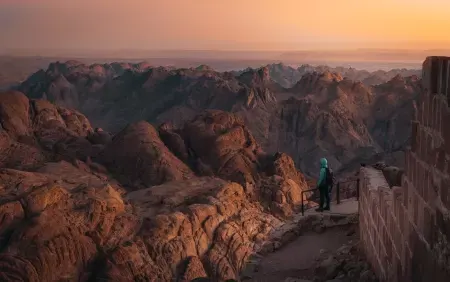St. Catherine's Monastery is not only a religious site but an architectural wonder, where ancient history converges with a remarkable design. The splendid architecture of the monastery reflects the beautiful Byzantine and early Christian influences of the time, being a space both spiritually elevated and aesthetically captured.
St. Catherine's Monastery is among the oldest, still-functioning monasteries in the world, Located at the foot of Mount Sinai in Egypt, Dating back to the 6th century, it has been declared a UNESCO World Heritage site, famed for its rich history, stunning architecture, and religious significance. Dedicated to St. Catherine of Alexandria, it boasts one of the most important collections of Christian manuscripts and icons. Visiting this sacred site is an immersive experience into the religious and cultural heritage of Egypt. A Sharm El Sheikh day tour to St. Catherine's Monastery shall provide an exciting opportunity to discover this historic treasure deep in the heart of the Sinai Peninsula. The course perfectly matches breathtaking scenery with a deep dive into centuries of tradition that makes this site a must-see for history enthusiasts as well as spiritual travelers.
The Role of St. Catherine's Monastery in Christian and Islamic Heritage
St. Catherine's Monastery is unique and globally among the most important sites of Christian and Islamic faith. It rests at the foot of Mount Sinai, which is a sacred place for the two faiths. The monastery actually contributes quite a lot to the spiritual and cultural heritage of the Christian and Muslim traditions. The close interrelation between these two Abrahamic faiths is illustrated by the rich religious history and the role the monastery plays in the lives of millions of followers worldwide.
A Christian Sanctuary: Legacy of St. Catherine
As one of the most important pilgrimage sites in the world, St. Catherine's Monastery is of great significance to Christians. The monastery was built in honor of St. Catherine of Alexandria, a Christian martyr of the fourth century who was prized for her wisdom and fidelity to her religion. According to Christian traditions, St. Catherine was martyred after refusing to renounce Christianity and was laid to rest on Mount Sinai, to which her body was said to have been brought by angels. Because of its close connection to the life and death of this great martyr, the monastery remains an enduring symbol of Christian martyrdom and devotion.
The monastery's long Christian heritage is further expressed in the great wealth of manuscripts, religious icons, and holy relics that it possesses, many of which date back to the early centuries of Christianity. These relics, which act as a window into the history and teachings of Christianity, form an important part of the spiritual life of these believers. This is especially true concerning the Church of the Transfiguration, where the grand Byzantine mosaics constitute a source of reflection for Christians visiting this sainted site.
Islamic Reverence for Mount Sinai
For Muslims, Sinai is a revered site as well. It is said that it was here that Prophet Moses (Musa in Arabic) received the divine revelations from God, including the Tablets of the Law, which may be considered one of the great establishing events of the Abrahamic faiths. Indeed, with Moses being a great prophet in Islam, the association with Sinai further enhances the area's spiritual clout. Many Muslims come to the area to pay respects to the memory of Moses and to gain the blessings that accompany the path he walked.
St. Catherine's Monastery, close to Mount Sinai, figures in the Islamic tradition as a place associated with Prophet Moses. The mention of Moses along with his encounters with God in several chapters of the Quran bolsters the association of the site with Islamic religious thought. While the monastery is primarily a Christian institution, within the Islamic tradition's reverence for Moses and Sinai lies the evidence of a common heritage shared by the two faiths.
A Shared Spiritual Heritage
Mount Sinai presents itself, in both the Christian and Islamic tradition, as the place where God communicated with humanity. The monastery's affiliation with Christianity and Islam exemplifies the united heritage of these two ideologies. The fact that both religions, from the vantage point of their own mythology, view the same piece of geography as sacred means that the histories of the two religions have crossed paths from another angle of the Abrahamic tradition.
As far as both the Christian and Muslim faiths are concerned, the place where the monastery offers room for prayers, quiet reflection, and worship manifests the genuine unbreakable spirit that is, and must be, maintained between the two faiths. Two souls—the pilgrims coming from various corners of the world, either Muslim or Christian—draw comfort and sense from the sacred grounds of St. Catherine's Monastery, which become symbols of coexistence and shared respect.
St. Catherine's Monastery: A Symbol of Tolerance and Coexistence
A testament to the coexistence of faiths over hundreds of years, St. Catherine's Monastery is a crossroads for Christians, Muslims, and other religions. In the past, it has been a refuge for not only Christian monks but for travelers and pilgrims of all faiths. It has had a long history as a safe haven for scholars, pilgrims, and monks, thus symbolizing the ability of religious communities to share space together and to seek common work.
The monastery's strength in Christian and Islamic heritage is a vivid reminder of the importance of tolerance and dialogue between religions. It gives room for all to meditate on their shared spirit and to join in those profound narratives and teachings that have molded the contemporary world for its major religions.
Interfaith Relations at St. Catherine's Monastery
In modern times, St. Catherine's Monastery continues to be a neutral meeting point for the general pilgrimage, but also for representatives of both religious communities trying to grasp and appreciate one another's beliefs. It remains a beacon of interfaith dialogue, displaying the opportunities for mutual respect and peaceful coexistence.
Architectural Wonders: Visiting the Beautiful Design of the Monastery
The Fortress-like Exterior
These walls barricaded the inhabitants and the holy treasures from
the desert-borne invaders, as though building a fortress. The high and intimidating walls were constructed by Emperor Justinian I in the 6th century for keeping the monastic community safe with its irreplaceable treasures. These walls, made from local granite, add to the monastery's rocky and imposing profile, making it one of the best examples of Byzantine defensive architecture.
The Entrance and the Courtyard
When you enter the monastery premises, you will be welcomed in peace with a calm courtyard standing in stark contrast to the fortress-like exterior. The central courtyard space of the monastery, with the important Burning Bush, is encircled with the monastic buildings. The quiet atmosphere invites one to meditation and prayer to give the pilgrim an extraordinary experience at the spiritual core of this site. It contains a lot of greenery and intricately paved stones to create an oasis of the desert.
The Main Church: A Byzantine Masterpiece
The Church of the Transfiguration, the grand interior of which is ornamented with breathtaking mosaics dating from the 6th century, lies within the monastery. Most of them depict biblical scenes, such as the Transfiguration of Christ, and are thought to be among the most important representatives of Byzantine art to have survived. With a simple but stately architectural design, the church glows with a sense of respect and sacredness, attracting a deeper understanding of awe from worshippers and tourists.
The Bell Tower
The monastery bell tower next to the church is another architectural feature that altogether enhanced the site's distinctiveness. The bell tower was built to announce prayers and important events of the monastic community. It is a symbol of the endurance of the monastery as well as its attachment to both spiritual and physical planes.
Icons and Religious Art of the Monastery
Around the monastery, there are innumerable icons and pieces of religious art augmenting the beauty of the architecture. Most of these religious artworks are locked away in the Icon gallery housing Christ, the Virgin Mary, and saints' lives portrayed in their various happenings. The presence of these icons lends an intense spiritual dimension to the design of this monastery, making it, besides the gathering for worship, a headspace for deep thought on Christian theology and history.
The Old Library
Yet another architectural jewel in St. Catherine's Monastery is its famous library, home to a collection of more than 3,000 manuscripts written in antiquity. At the library, most of the historical and theological treasures have been fittingly housed in beautifully designed shelves and cabinets that match the aesthetics of the whole monastery. The library's sacred task, as implied in its architecture, involves a kind of sanctuary in learning and preservation of knowledge, with its ancient wooden beams and vaulted ceilings producing a flavor of timelessness.
The Sacred Surroundings
The height from which the monastery drapes brings even greater architectural beauty thanks to Mount Sinai. The rugged, dry desert and the great mountain tower over the landscape within which the monastery approximates an organic growth from environment to space, closely complementary to the natural world. The design is very simple and austere and is in itself a reflection of the surrounding unreliability of the desolate desert itself so that even here earthly beings can encounter the heavenly.
Visiting St. Catherine's Monastery: Tips for Travelers
1. Plan for the Journey to the Monastery
St. Catherine's Monastery being in a remote area of Egypt's Sinai Peninsula means that the journey will take considerable time. Usually, the common place of departure is from Sharm El Sheikh, which is approximately a 2-3 hour trip by car. Most travelers prefer to book a Sharm El Sheikh day tour to St. Catherine's Monastery. These tours typically include transportation, a guide, and hiking options for Mount Sinai. Private transportation can also be arranged or a bus taken from any of the adjacent cities.
2. Dress Modestly
St. Catherine's Monastery is an active site of worship, and modest attire is essential. Both men and women should wear long-sleeved tops and bottoms covering at least the knee. One should also avoid tight-fitting garments and anything that may be considered as too revealing. If you intend to hike Mount Sinai, wear any weather-appropriate clothing beside good walking shoes.
3. Visit Early or Late to Avoid Crowds
The monastery gets busy, especially during peak tourist seasons, so early or late visits may provide more solitude. If visiting in the early hours, enjoy captivating enlightenment over its ambience before tour groups arrive. If you want to add a hike on Mount Sinai to your plans, sunrise or sunset are the best times to do it for magnificent views and to escape the midday heat.
4. Guided Tours
Having a guide will considerably enhance your visit to St. Catherine's Monastery. An experienced guide can provide historical, cultural, and religious perspectives about the significance of this site, including stories from the monastery's history to the Burning Bush and the link to Mount Sinai. Most tours from Sharm El Sheikh would provide a local guide to give further insights into the area during your visit.
5. Bring Water and Snacks
While there are little shops selling drinks and snacks around the monastery, it is wise to take your own water, especially if you aim for hiking on Mount Sinai. The region is arid, and it can get pretty hot; hence, staying hydrated becomes extremely essential. If you're hiking to get to witness the sunrise, it will be smart to grab some light snacks for energy along the way.
6. Don't Miss the Burning Bush
A prominent and significant feature of St. Catherine's Monastery is the Burning Bush, which is reputed to be the bush through which God spoke to Moses in the biblical account. It is situated in the monastery courtyard and should be seen by anyone who visits. The bush itself is a living plant, cared for and nurtured through the ages, and symbolizes divine presence to both Christians and Muslims.
7. Respect the Sacred Environment
While at St. Catherine’s Monastery, consideration for the spiritual environment is paramount. Restrict noise, refrain from taking photos in restricted areas (e.g., prayer time), and be sensitive to those there for religious purposes. Since this is a place of worship, it is incumbent upon you to act in a manner that is congruent with the respect the site commands.
8. Icon Gallery and Library
The Icon Gallery houses some of the most important Christian icons in the world and is one of the monastery's principal tourist attractions. These Byzantine masterpieces from the 6th to 10th centuries show visitors early Christian history. The library of the monastery is also worth visiting, for it has one of the most significant collections of ancient Christian manuscripts in the world. If religious history is your thing, take your time to visit these invaluable wonders.
9. Consider Hiking Mount Sinai
The second very popular thing visitors do during a visit to St. Catherine's Monastery is to hike Mount Sinai just behind the monastery. According to Christians, that is the place where Moses is accepted to have received the Ten Commandments, and for many people, it is a spiritual journey in its own right. The average time for the hike is 2-3 hours one way, and there are two major routes: Camel Path, a longer gentler route, and the Steps of Repentance, a shorter steeper path. Most people hike at night to reach the summit in time to see the sunrise, which offers spectacular panoramic views of the desert and mountains around.
10. Be Prepared for the Weather
The Sinai Desert has considerable temperature differences. During the day, especially in the summer, it may get fairly hot, so remember to use sunscreen, wear a hat, and put on sunglasses. Nighttime temperatures, especially on a Mount Sinai hike or in the winter season, can drop quickly. Bring some layers to ensure your comfort 24/7.
St. Catherine Monastery is a historical, spiritual, and richly layered experience in the desert. One of its major assets is Egypt. It is the must-see place for every Egypt tour. Also, it is located very close to the Red Sea; hence, it is one of the main Red Sea attractions, the most sought after by those worldwide who come to visit the ancient beauty and an environment that is so quiet.












